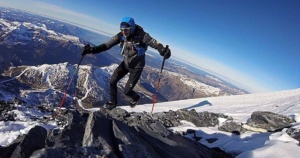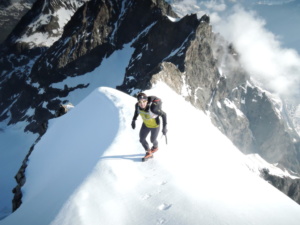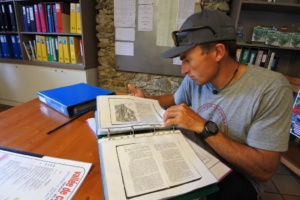One of the most radical climbers of the current generation, Ueli Steck had earned the title of ‘the Swiss machine’ for his bold attempts. An accident on Nuptse in April 2017 marked the end of a legend.

First published:
https://scroll.in/field/836341/ueli-steck-1976-2017-the-swiss-machine-who-chased-evolution
Ueli Steck (1976-2017): The Swiss machine who chased evolution
The world-famous 40-year-old mountaineer from Switzerland perished near Mount Everest in an expedition on Sunday
Like any athlete in the world, Ueli Steck’s sole attempt was to push the envelope each time he set out – see how far he could go, rather than how high. It earned him the moniker, “The Swiss Machine” over a period of time.
Mountaineering and endurance go hand-in-hand, but what the Swiss mountaineer chased was evolution – to show the world what else there was to be done after the last big mountains had been climbed. Steck’s death on Nuptse this week was during another attempt to do just that.
Since Annapurna was first climbed in 1950, Everest in 1953 and Shishapangma – the last of the 14, 8,000-metre peaks in the world – in 1964, mountaineers started looking at different routes up these same mountains to register another set of firsts, alongside winter ascents in extreme conditions. In line with that evolution, Steck represented the next generation of climbers who defined some of the new projects in the world of mountaineering, which at one time would have been considered quite unthinkable but today, can best be described as radical.
The master of speed ascent
Doug Scott, a renowned English mountaineer who was known to stretch his limits, defined speed ascents as “a sign of crazy efficiency and skill”, though he is still averse to the idea of storming up a mountain as compared to relishing every altitude gained. Scott came from an era when getting to the top was the goal. Steck, on the other hand, not only looked to get to the top, but it also mattered to him how soon he got there. It was an expression of how effectively one could tackle a mountaineering puzzle on hand.
Training was the key to arriving at this solution. Like any other athlete, Steck had a support team that helped him understand the science behind how his body performed in different conditions. Then, he believed in light, alpine-style ascents with minimal equipment and a bivouac at most when needed, rather than the expedition style of setting up camps at various altitude. His acclimatisation runs too featured climbing to higher altitudes and descending rapidly, as compared to spending nights in a tent higher up on the mountain. All this, without the aid of supplemental oxygen, true to the spirit of mountaineering.
This meant that in addition to being a good climber, Steck also needed to have the endurance to go up and down the mountain multiple times – and as fast as possible – before the weather turned or his own levels dropped. Though it minimised the risk on one hand since he spent less time on the mountain, it also meant that his body had to live up to the speed demands and at those altitudes.

The Alps doubled up as his backyard at home in Ringgenberg in the Interlaken region of Switzerland; the north face of the Eiger nearby, soon became a pet project. He first set a speed record of 3 hours 54 minutes in 2007, bettering the mark the following year at 2 hours 47 minutes. When a young climber and countryman Dani Arnold managed to get to the top in 2 hours 28 minutes, Steck took on the challenge to reset the mark at 2 hours 22 minutes 50 seconds in 2015 – a time that stands till date.
Challenging the Annapurna
Quite naturally, his attention turned to the lure of the Himalayas. In 2007, he took on Annapurna’s main south face that had remained unclimbed despite many attempts. It ended after a loose rock hit him on the head and hurled him 300 metres down the face. He came back the following year to attempt a technical climb up the north-west face of Teng Kang Poche, the first attempt cut short by weather, only to go back up two weeks later and manage a first ascent alongside Simon Anthamatten. It was considered worthy of the Piolet d’Or in 2008, an award recognising top mountaineering feats around the world.
Annapurna though was unfinished and on his mind. Steck returned in 2008 and failed once again due to poor conditions on the mountain.
Other projects beckoned there on. In a single season in 2011, he blazed up Shishapangma and Cho Oyu, before returning from Everest just short of the summit. The following year, he succeeded on Everest as well. It took him another five years of preparation to come back to Annapurna.
“Adventures stand out because you can never calculate in advance what all could happen… nothing is for sure. To walk through life in a comfortable way is still not my goal. This is why I want to try and climb Annapurna a third time. I would like to implement my dreams and visions into reality. Annapurna is one of them,” he had written before the climb.
By the end of that year, he had another Piolet d’Or to his name for success on Annapurna, registering the first, solo ascent up one of the most treacherous faces in just 28 hours. This, despite having no proof of the climb – even the customary photograph on the summit was missing after he lost his camera – which speaks volumes of his reputation.
Persistence, then was something that urged Steck to get out of his comfort zone and do what was needed to attain the targets he sought. After an unsuccessful climb, he would go back to the drawing board, rework his strategy and come back stronger to get the job done. And in the process, set the bar higher for the rest of the fraternity.

‘I wanna do more’
Climbing of course was central to Steck, but he also an accomplished ultra runner, cyclist and paraglider. A fun project in 2015 saw him climb to the top of all the 82 summits of the Alps, which are over 4000 metres, in a single push and without any mechanical aid. He would run to the base of a mountain, ascend and descend it, run back to his bicycle, before riding over to the next mountain.
On a particular day, he managed 18 summits alongside Andreas Steindl, which speaks volumes of his strength as well as the joy he associated with climbing. There were no records in sight; it was a project to enjoy with his wife, Nicole, and friends, who joined in on a number of climbs. By the end of it, he had attained his goal in 62 day – just two days past the record. What he loved most about that project were the long traverses across these mountains, something he had said, “I wanna do more”.
In the spring of 2017, there were a number of other climbers from his generation hoping to set new benchmarks just like him, well aware of the dangers associated with it. Kilian Jornet is gearing up for a lightweight, speed ascent of Everest from the north side on which he was unsuccessful last year while David Goettler and Herve Marmasse are looking at a new route up Shishapangma. Simone Moro attempts another daring traverse on Kanchenjunga. Steck had last been to Everest in 2013, when he returned after a much-publicised quarrel with Sherpas.
This time around, what he had in mind for him and his climbing partner, Tenji Sherpa, would demand his best yet.
A daring challenge
The idea was to go up Everest via the West Ridge, traverse the South Col and link-up with neighbouring Lhotse, the fourth highest mountain in the world, before returning to Base Camp. Just the route he selected up Everest had tested two top climbers of their time – Tom Hornbein and Willi Unsoeld. The duo on the American team had made a daring attempt in 1963 and made it to the summit against all odds before coming down to South Col – a feat that has never been repeated since.
Getting to the top of Everest then was enough of a challenge for the two, let alone the daunting traverse that would have followed. As part of the acclimatisation climbs, Steck had reached an altitude of 7,000 metres last week.
“Day by day, one by one. It is here and now that counts. What comes next is uncertain in any case,” he had said in a video before the climb.
“If you have an accident or if you’re going to die, that’s definitely not successful, all the other things, it’s a success already.”
On April 30, the climbing world lost one of its best on just one of those unsuccessful days.